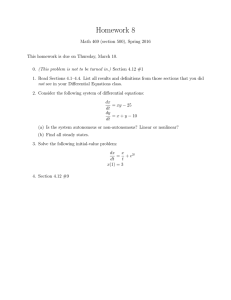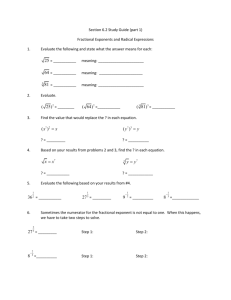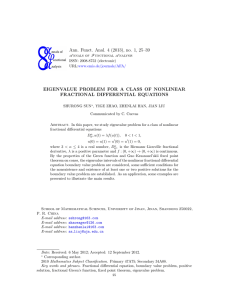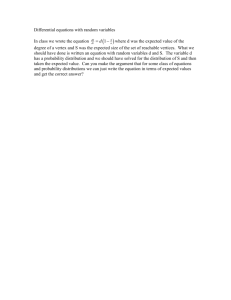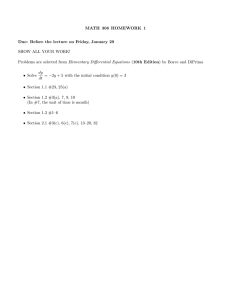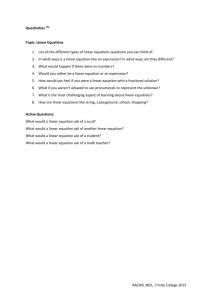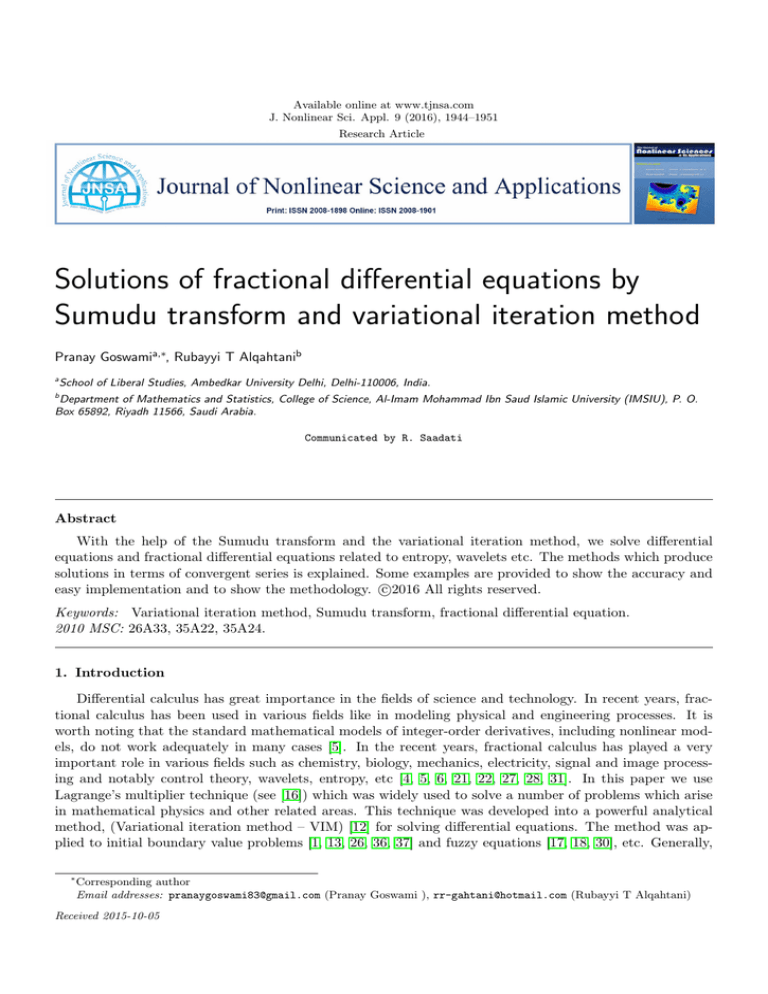
Available online at www.tjnsa.com
J. Nonlinear Sci. Appl. 9 (2016), 1944–1951
Research Article
Solutions of fractional differential equations by
Sumudu transform and variational iteration method
Pranay Goswamia,∗, Rubayyi T Alqahtanib
a
School of Liberal Studies, Ambedkar University Delhi, Delhi-110006, India.
b
Department of Mathematics and Statistics, College of Science, Al-Imam Mohammad Ibn Saud Islamic University (IMSIU), P. O.
Box 65892, Riyadh 11566, Saudi Arabia.
Communicated by R. Saadati
Abstract
With the help of the Sumudu transform and the variational iteration method, we solve differential
equations and fractional differential equations related to entropy, wavelets etc. The methods which produce
solutions in terms of convergent series is explained. Some examples are provided to show the accuracy and
c
easy implementation and to show the methodology. 2016
All rights reserved.
Keywords: Variational iteration method, Sumudu transform, fractional differential equation.
2010 MSC: 26A33, 35A22, 35A24.
1. Introduction
Differential calculus has great importance in the fields of science and technology. In recent years, fractional calculus has been used in various fields like in modeling physical and engineering processes. It is
worth noting that the standard mathematical models of integer-order derivatives, including nonlinear models, do not work adequately in many cases [5]. In the recent years, fractional calculus has played a very
important role in various fields such as chemistry, biology, mechanics, electricity, signal and image processing and notably control theory, wavelets, entropy, etc [4, 5, 6, 21, 22, 27, 28, 31]. In this paper we use
Lagrange’s multiplier technique (see [16]) which was widely used to solve a number of problems which arise
in mathematical physics and other related areas. This technique was developed into a powerful analytical
method, (Variational iteration method – VIM) [12] for solving differential equations. The method was applied to initial boundary value problems [1, 13, 26, 36, 37] and fuzzy equations [17, 18, 30], etc. Generally,
∗
Corresponding author
Email addresses: pranaygoswami83@gmail.com (Pranay Goswami ), rr-gahtani@hotmail.com (Rubayyi T Alqahtani)
Received 2015-10-05
P. Goswami, R. Alqahtani, J. Nonlinear Sci. Appl. 9 (2016), 1944–1951
1945
in solving initial value problems of differential equations by VIM, the crucial point is identifying the Lagrange multipliers. To solve fractional differential equations (FDEs) by this method, we may directly use
the Lagrange multipliers in ordinary differential equations (ODEs), which often results in poor convergence.
To improve this method, a few ideas are suggested. The Riemann–Liouville integral emerges in the constructed correctional functional, but the integration by parts is difficult to apply. To avoid this problem,
the Riemann–Liouville integral is replaced by an integral which allows the integration by parts. This is a
very strong simplification but it affects the whole process after that step. Therefore, the Lagrange multiplier
is determined by a simplification, not reasonably explained in the literature, so far. The technique can be
universally extended to solve both ordinary differential equations and fractional differential equations with
initial value conditions.
2. Basics of the Variational Iteration Method
To illustrate the basic idea of this method, we consider the following general nonlinear system
dm u(t)
+ L[u(t)] + N [u(t)] = g(t),
(2.1)
dtm
where L is a linear operator, N is a nonlinear operator, g(t) is a known continuous function and m is the
order of the highest-order derivative of the function. The basic characteristic of the method is construction
of the following correctional functional for (2.1):
m
Z t
d u
un+1 = un +
λ (t, τ )
+ L[u] + N [u] − g(τ ) dτ,
dτ m
0
where λ (t, τ ) is called the general Lagrange multiplier [16] and un is an approximate solution of nth order.
Concerning the VIM [12], we know that the integration by parts plays an important role in the determination of Lagrange multipliers. But in fractional calculus, generally, the following integration by parts
cannot be done
α C α
t
α C α
0 It vo Dt u = [uv] |0 − 0 It uo Dt v,
α
α
where C
0 Dt is the well known Caputo derivative, 0 It is the Riemann–Liouville fractional integral and
v = v(t). This is a particular case of VIM, for which this method is not so successful as other analytical
methods like the Adomian decomposition method (ADM) [10, 29, 32] and the homotopy perturbation method
(HPM) [19, 24, 33] in fractional calculus. To remove this obstacle, we consider the following reconstruction
of the method, using the Sumudu transform.
3. Sumudu Transform and the Mittag-Leffler Function
In early 90’s, Watugala [2] introduced a new integral transform named the Sumudu transform and applied
it to solve ordinary differential equations in engineering control problems. The Sumudu transform is defined
over the set of functions:
A = {f (t) | ∃M, τ1 , τ2 > 0, |f (t)| < M e| t |τj , if t ∈ (−1)j × [0, ∞)}
by
Z
∞
G̃(u) = S[f (t)] =
f (ut)e−t dt,
u ∈ (−τ1 , τ2 )
0
see [3, 7, 20, 23].
By using Sumudu transform of multiple differentiation, we obtain
"
#
m−1
X f k (0)
C α
G̃(u)
S 0 Dt f (t) = um−α
−
,
um
um−k
k=0
"
#
m−1
G̃(u) X f k (0+)
=
−
,
(m − 1 < α ≤ m) ,
uα
uα−k
k=0
(3.1)
P. Goswami, R. Alqahtani, J. Nonlinear Sci. Appl. 9 (2016), 1944–1951
1946
where G̃(u) = S [f (t)].
The Mittag-Leffler function, which is a generalization of the exponential function, is defined by [11]:
Eα (z) =
∞
X
n=0
zn
Γ (αn + 1)
(α ∈ C, Re(α) > 0) .
4. Identification of the Lagrange Multipliers and Basic idea of VIM by Sumudu Transform
We will see the whole process of the Lagrange multipliers in the case of an algebraic equation. The
solution of the algebraic equation f (x) = 0 can be obtained by an iteration formula
xn+1 = xn + λf (xn ) .
The optimality condition for the extreme
δxn+1
δxn
(4.1)
= 0, leads to
λ=−
1
f 0 (x
n)
,
(4.2)
where δ is the classical variational operator. By using given initial value x0 , we can find the approximate
solution xn+1 by the following iterative scheme, using (4.1) and (4.2)
xn+1 = xn −
f (xn )
, f 0 (x0 ) 6= 0, n = 0, 1, 2, . . . .
f 0 (xn )
(4.3)
The above defined formula (4.3) is well known as the Newton–Raphson formula and has quadratic convergence.
In this paper we extend this idea to find the unknown Lagrange multiplier. In this process, first we
apply the Sumudu transform to (2.1), and get
u−m v (s) − u−m v(0) − · · · − u−1 v m−1 (0) + S (R [v] + N [v]) = S (g(t)) .
Using (4.1), the iteration formula (4.4) can be written as
v̄n+1 (u) = v̄n (u) + λ(u) u−m v (u) − u−m v(0) − · · · − u−1 v m−1 (0) + S (R [v] + N [v]) − S (g(t)) ,
(4.4)
(4.5)
where λ (u) = −um .
By applying the inverse Sumudu transform, S −1 to (4.5), after putting the value of λ (u), we get
vn+1 (t) = vn (t) − S −1 um u−m v (u) − u−m v(0) − · · · − u−1 v m−1 (0) + S (R [v] + N [v]) − S (g(t))
= S −1 v(0) + · · · + um−1 v m−1 (0) + um (S (R [v] + N [v]) − S (g(t))) .
where the initial iteration v0 (t) is
v0 (t) = S −1 v(0) + · · · + um−1 v m−1 (0) ,
= v(0) + v 0 (0) t + · · · +
tm−1 v m−1 (0)
.
(m − 1)!
(4.6)
The formula (4.6) shows why the initial iteration in the classical VIM is determined by Taylor series.
5. Application to ODEs
In this section, we apply the above defined method to solve both ordinary differential equations and
fractional differential equations.
P. Goswami, R. Alqahtani, J. Nonlinear Sci. Appl. 9 (2016), 1944–1951
1947
Example 5.1. Consider the following radioactive-decay differential equation:
dN
= −αN,
dt
N (0) = N0
where N (t) is the number of radioactive nuclei at time t and N0 the number at t = 0, and if their rate of
decay (−dN/dt) is proportional to the number of undecayed nuclei, with the constant of proportionality α,
then we can obtain successive approximate solutions by
N0 (t) = N (0) = N0 ,
N1 (t) = S −1 (1 − uα) N0 = N0 (1 − tα) ,
α2 t2
−1
2 2
,
N2 (t) = S
1 − αu + α u N0 = N0 1 − αt +
2!
n n
n+1 α t
−1
n+1 n n
Nn (t) = S
1 − αt + · · · + (−1)
α u N0 = N0 1 − αt + · · · + (−1)
.
n!
As n → ∞, Nn (t) tends to the exact solution N0 e−αt .
Example 5.2. Consider the following differential equation:
d2 v
+ v = 0,
dt2
v(0) = 2,
v 0 (0) = 3,
We can obtain successive approximate solutions
v0 (t) = v(0) = 2,
v1 (t) = S
−1
v2 (t) = S −1
2t2
2 + 3u − 2u = 2 + 3t −
,
2!
2t2 3t3 2t4
2
3
4
2 + 3u − 2u − 3u + 2u = 2 + 3t −
−
+
,
2!
3!
4!
2
As n → ∞, vn (t) tends to the exact solution 2 cos t + 3 sin t.
There exist a lot of choices of v0 (t) and λ (u) which affect the speed of the convergence.
We note that the integration by parts is not used and the calculation of the Lagrange multiplier here is
much simpler. The VIM can be easily extended to FDEs and this is important and the main purpose of our
work.
6. Application to FDEs
To illustrate the basic idea of this method for fractional differential equations, we consider a general
nonlinear nonhomogeneous fractional differential equation with initial conditions of the following form
C α
0 Dt v
+ L(v) + N (v) = g (t) ,
subject to the initial conditions
v (k) 0+ = dk , 0 < t, 0 < α, m = [α] + 1, k = 0, 1, . . . , m − 1,
α
where C
0 Dt v is the Caputo derivative [6].
(6.1)
P. Goswami, R. Alqahtani, J. Nonlinear Sci. Appl. 9 (2016), 1944–1951
1948
The first step of this method is an application of the Sumudu transform to both sides of (6.1) (the
α
Sumudu transform of C
0 Dt v is defined by (3.1)) we get
"(
)#
m−1
X v k (0+)
−α
v n+1 (u) = v n (u) + λ(u)
u v (u) −
+ S (R [v] + N [v]) − S (g(t))
.
(6.2)
uα−k
k=0
Puting λ = −uα , the Lagrange multiplier in (6.2) and applying the inverse Sumudu transform, we get
" (
)#
m−1
X v k (0+)
vn+1 (t) = vn (u) − S −1 uα u−α v (u) −
+ S (R [v] + N [v] − g(t))
uα−k
k=0
)#
"(m−1
X v k (0+)
− uα S (R [v] + N [v] − g(t))
,
= S −1
u−k
k=0
where
v0 (t) = S
−1
m−1
X
k=0
v k (0+)
u−k
or
v0 (t) = v(0) + v 0 (0) t + · · · +
!
,
tm−1 v −m+1 (0)
.
(m − 1)!
Example 6.1. Consider the following fractional-order logistic differential equation see [8, 25]:
C α
0 Dt v(t)
= rv(t)(1 − v(t)),
t > 0, r > 0, 0 < α ≤ 1,
(6.3)
with the initial condition
v(0) = v0 .
We get the first two successive approximate solutions by
v0 (t) = v(0) = v0 ,
v1 (t) = S
−1
uα v0 − v02
v0 +
2
!
v0
=
2
tα (1 − v0 )
2+
Γ(α + 1)
.
Particular Case. If we take r = 1/2, and the initial condition v(0) = 1/2, we can obtain successive
approximate solutions
v0 (t) = v(0) = 1/2,
uα
1
0.125 tα
−1 1
+
=
+
,
v1 (t) = S
2
8
2 Γ(α + 1)
uα u3α
1
0.125 tα
0.0078125 t3α
−1 1
v2 (t) = S
+
−
=
+
−
.
2
8
128
2 Γ(α + 1)
Γ(3α + 1)
As n → ∞, vn (t) tends to the exact solution of (6.3). For α = 1, we have v(t) =
et/2
.
1+et/2
Example 6.2. Consider the relaxation oscillator equation
C α
0 Dt v
+ ω α v = 0,
v(0) = 1,
v 0 (0) = 0,
0 < t, 0 < α < 2, ω > 0.
Applying the Sumudu transform to (6.4), we get the following iteration formula
v (u) v(0) v 0 (0+ )
α
v n+1 (u) = v n (u) + λ(u)
− α − α−1 + ω S (vn ) ,
uα
u
u
(6.4)
P. Goswami, R. Alqahtani, J. Nonlinear Sci. Appl. 9 (2016), 1944–1951
1949
as a result, after identifying a Lagrange multiplier λ = −uα , approximate solutions of (6.4) can be found by
v(0) v 0 (0+ )
α v (u)
−1
α
u
vn+1 (t) = vn (u) − S
− α − α−1 + ω S (vn ) ,
uα
u
u
or
vn+1 (t) = S
−1
α
u
v(0) v 0 (0+ )
− α−1 + ω α S (vn )
uα
u
,
wherefrom
v0 (t) = v(0) = 1,
v1 (t) = S
−1
v2 (t) = S −1
ω α tα
,
Γ (1 + α)
ω α tα
ω 2α t2α
α α
2α 2α
1−ω u +ω u
= 1−
.
+
Γ (1 + α) Γ (1 + 2α)
(1 − ω u ) = 1 −
α α
As n → ∞, vn (t) tends to the exact solution Eα ((−ωt)α ) [25], where Eα ((−ωt)α ) denotes the MittagLeffler function, see [7].
Example 6.3. Consider the time-fractional diffusion equation
C α
0 Dt v
=
∂ 2 v(x, t) ∂ (x v(x, t))
+
,
∂x2
∂x
0 < α < 1,
(6.5)
with
v(x, 0) = x2 .
Das [14] found the VIM solution of the fractional semi-derivative equation. Other methods applied to this
equation are available in [9] and in the monographs [4, 34] on fractional calculus.
As a result, after identifying a Lagrange multiplier λ = −uα , approximate solutions of (6.5) can be found
by
2
∂ vn (x, t) ∂ (x vn (x, t))
−1
2
α
+
,
vn+1 (t) = S
x +u S
∂x2
∂x
wherefrom
v0 (t) = v(0) = x2 ,
v1 (t) = S
−1
v2 (t) = S
−1
x2 + 2 + 3x
2
2
x + 2 + 3x
2
uα =
α
!
2 tα
2
+
3x
x2 −
,
Γ (1 + α)
u + 8 + 9x
2
2α
u
=
!
8 + 9x2 t2α
2 + 3x2 tα
+
.
x +
Γ (1 + α)
Γ (1 + 2α)
2
As n → ∞, vn (t) tends to the exact solution Eα (k i tα ) [25], where Eα (k i tα ) denotes the Mittag-Leffler
function and k i = x2 + (1 + x2 )(3i − 1).
The efficiency of the method for a nonlinear differential equation with variable coefficients is illustrated in
[15]. For other applications of a new modified VIM to ODEs and FDEs, readers are referred to [4, 15, 34, 35].
Acknowledgements
The authors are thankful to the referee for his/her fruitful comments to improve this paper.
P. Goswami, R. Alqahtani, J. Nonlinear Sci. Appl. 9 (2016), 1944–1951
1950
References
[1] T. Allahviranloo, S. Abbasbandy, H. Rouhparvar, The exact solutions of fuzzy wave-like equations with variable
coefficients by a variational iteration method, Appl. Soft Comput., 11 (2011), 2186–2192. 1
[2] A. Atangana, D. Boleanu, Nonlinear fractional Jaulent-Miodek and Whitham-Broer-Kaup equations within
Sumudu transform, Abstr. Appl. Anal., 2013 (2013), 8 pages. 3
[3] A. Atangana, A. Kilicman, The use of Sumudu transform for solving certain nonlinear fractional heat-like equations, Abstr. Appl. Anal., 2013 (2013), 12 pages. 3
[4] D. Baleanu, K. Diethelm, E. Scalas, J. J. Trujillo, Fractional Calculus: Models and Numerical Methods. Series
on Complexity, Nonlinearity and Chaos, World Scientific, Singapore, (2012). 1, 6.3, 6
[5] M. Caputo, Linear models of dissipation whose Q is almost frequency independent, II, Geophys. J. R. Astr. Soc.,
13 (1967), 529–539. 1
[6] C. Cattani, Fractional calculus and Shannon wavelet, Math. Probl. Eng., 2012 (2012), 26 pages. 1, 6
[7] V. B. L. Chaurasiya, R. S. Dubey, F. B. M. Belgacem, Fractional radial diffusion equation analytical solution via
Hankel and Sumudu transforms, Int. J. Math. Eng. Sci. Aerospace, 3 (2012), 1–10. 3, 6.2
[8] S. Das, Analytical Solution of a Fractional Diffusion Equation by Variational Iteration Method, Comput. Math.
Appl., 57 (2009), 483–487. 6.1
[9] K. Diethelm, The Analysis of Fractional Differential Equations, Springer, Berlin, (2010). 6.3
[10] J. S. Duan, R. Rach, D. Baleanu, A. M. Wazwaz, A review of the Adomian decomposition method and its
applications to fractional differential equations, Commun. Fractals Calc., 3 (2012), 73–99. 2
[11] A. M. A. El-Sayed, A. M. A. El-Mesiry, H. A. A. El-Saka, On the fractional-order logistic equation, Appl. Math.
Lett., 20 (2007), 817–823. 3
[12] J. H. He, Variational iteration method - A kind of non-linear analytical technique: some examples, Int. J. NonLinear Mech., 34 (1999), 699–708. 1, 2
[13] J. H. He, An elementary introduction to recently developed asymptotic methods and nanomechanics in textile
engineering, Int. J. Modern Phys. B, 22 (2008), 3487–3578. 1
[14] J. Hristov, Heat-balance integral to fractional (half-time) heat diffusion sub-model, Thermal Sci., 14 (2010), 291–
316. 6.3
[15] J. Hristov, An Exercise with the He’s variation iteration method to a fractional Bernoulli equation arising in a
transient conduction with a non-linear boundary heat flux, Int. Rev. Chem. Eng., 4 (2012), 489–497. 6
[16] M. Inokuti, H. Sekine, T. Mura, General use of the Lagrange multiplier in nonlinear mathematical physics,
Variational Methods Mech. Solid., (1978), 156–162 . 1, 2
[17] H. Jafari, C. M. Khalique, Homotopy perturbation and variational iteration methods for solving fuzzy differential
equations, Commun. Fractals Calc., 3 (2012), 38–48. 1
[18] H. Jafari, M. Saeidy, D. Baleanu, The variational iteration method for solving n-th order fuzzy differential equations, Centr. Eur. J. Phys., 10 (2012), 76–85. 1
[19] A. Kadem, D. Baleanu, Homotopy perturbation method for the coupled fractional Lotka-Volterra equations, Romanian J. Phys., 56 (2011), 332–338. 2
[20] Q. D. Katatbeh, F. B. M. Belgacem, Applications of the Sumudu transform of fractional differential equations,
Nonlinear Stud., 18 (2011), 99–112. 3
[21] A. A. Kilbas, H. M. Srivastava, J. J. Trujillo, Theory and Applications of Fractional Differential Equations,
Elsevier, Amsterdam, (2006). 1
[22] K. S. Miller, B. Ross, An Introduction to the Fractional Calculus and Fractional Differential Equations, Wiley,
New York, (1993). 1
[23] G. M. Mittag-Leffler, Sur la nouvelle function Eα (x), C. R. Acad. Sci. Paris, 137 (1903), 554–558. 3
[24] S. Momani, Z. Odibat, Homotopy perturbation method for nonlinear partial differential equations of fractional
order, Phys. Lett. A, 365 (2007), 345–350. 2
[25] S. Momani, R. Qaralleh, Numerical approximations and Pade’ approximants for a fractional population growth
model, Appl. Math. Model., 31 (2007), 1907–1914. 6.1, 6.2, 6.3
[26] M. A. Noor, S. T. Mohyud-Din, Variational iteration technique for solving higher order boundary value problems,
Appl. Math. Comput., 189 (2007), 1929–1942. 1
[27] K. B. Oldham, J. Spanier, The Fractional Calculus, Academic Press, New York, (1974). 1
[28] I. Podlubny, Fractional Differential Equations, Academic Press, New York, (1999). 1
[29] S. S. Ray, R. K. Bera, An approximate solution of a nonlinear fractional differential equation by Adomian decomposition method, Appl. Math. Comput., 167 (2005), 561–571. 2
[30] N. T. Shawagfeh, Analytical approximate solutions for nonlinear fractional differential equations, Appl. Math.
Comput., 131 (2002), 517–529. 1
[31] M. R. Ubriaco, Entropy based on fractional calculus, Phys. Lett. A, 373 (2009), 2516–2519. 1
[32] Q. Wang, Homotopy perturbation method for fractional KdV-Burgers equation, Chaos Solitons Fractals, 35 (2008),
843–850. 2
[33] S. Weerakoon, Application of Sumudu transform to partial differential equations, Internat. J. Math. Ed. Sci. Tech.,
25 (1994), 277–283. 2
P. Goswami, R. Alqahtani, J. Nonlinear Sci. Appl. 9 (2016), 1944–1951
1951
[34] G. C. Wu, Challenge in the variational iteration method – A new approach to identification of the Lagrange
multipliers, J. King Saud Univ. Sci., 25 (2013), 175–178. 6.3, 6
[35] G. C. Wu, D. Baleanu, Variational iteration method for the Burgers’ flow with fractional derivatives – new
Lagrange multipliers, Appl. Math. Model., 37 (2013), 6183–6190. 6
[36] A. Yildirım, T. Ozis, Solutions of singular IVPs of Lane-Emden type by the variational iteration method, Nonlinear
Anal., 70 (2009), 2480–2484. 1
[37] E. Yusufoglu, The variational iteration method for studying the Klein-Gordon equation, Appl. Math. Lett., 21
(2008), 669–674. 1

